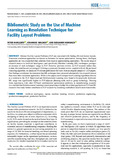Citation link:
http://dx.doi.org/10.25819/ubsi/9966Files in This Item:
| File | Description | Size | Format | |
|---|---|---|---|---|
| Bibliometric_study_on_the_use_of_machine_learning.pdf | 5.34 MB | Adobe PDF |  View/Open |
| Dokument Type: | Article | metadata.dc.title: | Bibliometric study on the use of machine learning as resolution technique for Facility Layout Problems | Authors: | Burggräf, Peter Wagner, Johannes Heinbach, Benjamin |
Institute: | Fakultät IV - Naturwissenschaftlich-Technische Fakultät | Free keywords: | Bibliometrische Studie, Anlagenlayoutprobleme, Bibliometric Study, Facility Layout Problems | Dewey Decimal Classification: | 620 Ingenieurwissenschaften und zugeordnete Tätigkeiten | GHBS-Clases: | ZHX | Issue Date: | 2021 | Publish Date: | 2021 | Source: | IEEE Access ; vol. 9, S. 22569-22586. - DOI: https://doi.org/10.1109/ACCESS.2021.3054563 | Abstract: | Facility Layout Problems (FLP) are concerned with finding efficient factory layouts. Numerous resolution approaches are known in literature for layout optimization. Among those, intelligent approaches are less researched than solutions from exact or approximating approaches. The recent surge of research interest in Artificial Intelligence, and specifically Machine Learning (ML) techniques, presages an increase of such techniques' usage in FLP. However, previous reviews on FLP research induce that, to date, this trend has not yet emerged. Utilizing a systematic literature review coupled with a k-Means based clustering algorithm, we analyzed 25 relevant publication full-texts from an original sample of 1,425 papers. Our findings corroborate the statement that ML techniques have attracted substantially less research interest than most other resolution approaches. While a few papers used Unsupervised Learning algorithms directly as a solution to the FLP, Supervised and Reinforcement Learning were found to be practically irrelevant. ML usage was significantly higher in FLP-adjacent planning tasks such as group technology. Drawing from experiences with other NP-hard combinatorial optimization problems in manufacturing research, we conclude that Reinforcement Learning is most promising to bridge the evident gap between FLP and ML research. Our study further contributes to FLP research by extending established classification frameworks. |
Description: | Finanziert aus dem Open-Access-Publikationsfonds der Universität Siegen für Zeitschriftenartikel |
DOI: | http://dx.doi.org/10.25819/ubsi/9966 | URN: | urn:nbn:de:hbz:467-19528 | URI: | https://dspace.ub.uni-siegen.de/handle/ubsi/1952 |
| Appears in Collections: | Geförderte Open-Access-Publikationen |
This item is protected by original copyright |
Page view(s)
405
checked on Nov 28, 2024
Download(s)
247
checked on Nov 28, 2024
Google ScholarTM
Check
Altmetric
Items in DSpace are protected by copyright, with all rights reserved, unless otherwise indicated.

